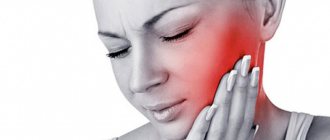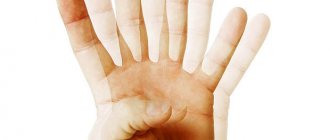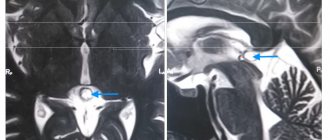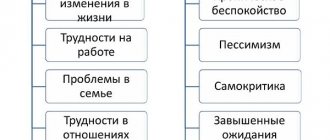Learn more about diseases starting with the letter “B”: Basilar impression, Basilar migraine, Beriberi, Bettolepsy, Amyotrophic lateral sclerosis, Alzheimer's disease, Wilson's disease, Hallerwarden-Spatz disease, Hamstorp disease, Hippel-Lindau disease, Canavan disease, Creutzfeldt disease -Jacoba, Lafora's disease, Machado-Joseph disease, Moya-moya disease, Morton's disease, Parkinson's disease, Pick's disease, Refsum's disease, Fahr's disease.
Migraine is classified into several different types of disease. One such type is basilar migraine. With this disease, various pathological changes occur in the basilar blood supply area.
Characteristic
Such a migraine is characterized directly by dizziness, ataxia, visual disturbances, hearing loss, sensory disorders, followed by an attack of headache.
This disease can be diagnosed by conducting studies such as X-rays of the brain, magnetic resonance or computed tomography of the brain, ultrasound or CT angiography of the vertebral arteries of the brain and spine, as well as by visiting a neurologist.
Pain and other disorders are relieved by inhalation of a mixture of carbon dioxide and oxygen. Prednisolone is also taken. Prevention against the disease is carried out directly in the interparoxysmal interval.
The basilar form of pathology is not as common as other types of this disease. The disease is classified as a particularly severe form, causing various complications. The blood supply to the brain is disrupted, which can lead to ischemic stroke.
Basilar migraine is distinguished by the absence of motor impairment, since similar basilar manifestations are present in familial hemiplegic migraine in most cases.
It has been noted that headaches mainly affect people aged 18 to 50 years; less often, this disease occurs in children and people whose age exceeds 50 years. In most cases, women are at risk. When diagnosed by specialists, difficulties often arise due to the various features of the manifestation of the disease.
Mechanism of occurrence
Doctors explain the mechanisms of development of this disorder by the occurrence of dysfunctions of proper blood circulation in parts of the brain.
When oxygen and nutrients do not reach the right areas, the brain reacts sharply, triggering the production of pain mediators and vasospasm.
Considering that the basilar artery directly feeds the cerebellum, medulla oblongata and labyrinth of the inner ear, a lack of blood circulation in these areas leads to ataxia, as well as hallucinations. The aura is followed by a severe headache.
Causes
Experts include the following reasons for the development of the disease:
suffered stress;- high consumption of energy drinks and coffee;
- smoking;
- irregular daily routine;
- sleep disturbance, chronic lack of sleep;
- genetic predisposition;
- taking contraceptives;
- hormonal disorders;
- abnormalities of the spine;
- craniovertebral anomaly;
- instability of the spine in the cervical region.
An important and fundamental role in the occurrence of the disease is played by vasomotor and reflex disorders.
Also, most experts associate headaches with hydrops of the labyrinth (the reaction of the epithelium to constant nociceptive irritation, which causes the development of endolymphatic edema). Basilar-type researchers believe that labyrinthine involvement results in more frequent dysfunction and cochlear neuritis in people suffering from this disease. But, at the same time, hydrops can be considered a complication of migraine.
Risk factors and provocateurs
Risk factors that provoke the development of basilar migraine are:
- smoking and drinking alcohol in large quantities;
- lack of sleep or excess, improper daily routine;
- influencing the body by allergens;
- changing contraceptives or abruptly abandoning them;
- hazardous work conditions or poor environmental conditions.
Signs of illness
Symptoms for this type of disease manifest themselves as follows:
dizziness;- noise in ears;
- visual disorder consisting of double vision of visible objects;
- violation of the coordination of movements of various muscles in the absence of muscle weakness;
- hearing loss;
- speech disorders that arise due to damage to the central nervous system;
- disorder of consciousness;
- sensory disturbances;
- bilateral visual phenomena such as flashes of light and spots;
- amaurosis.
The above symptoms of the disease are transient and disappear within 10 minutes. Sometimes symptoms appear sequentially and in several types at once. The duration of symptoms is about 1 hour.
More than 50% of people suffering from this pathology have transient focal neurological deficits. Less common is a prolonged manifestation of migraine in the form of a headache, lasting about 8 hours.
After the migraine aura ends, a unilateral headache occurs, located in the occipital region and manifested by throbbing.
There is also cephalalgia, which is located not only in the occipital region. Most patients with this type of pain complain of a severe aura, which is why some patients are unable to characterize the headache. This is why it can be difficult for specialists to diagnose this type of disease.
Less than 50% of people with basilar migraine complain of nausea and vomiting, as well as photophobia. It is also noted that patients may experience fainting and unconsciousness, followed in rare cases by short-term memory loss.
The disease is stable, with paroxysms occurring every few weeks or months. It is noted that as the patient’s age increases, the duration and intensity of the manifestation of the pathology decreases.
Prevention
In the case of migraine, prevention is almost a panacea. Of course, it is not possible to get rid of basilar migraine 100%, but it is quite possible to significantly alleviate the condition. In order to prevent paroxysms, you need to:
- Avoid smoking and drinking alcohol;
- Sleep at night for at least 8 hours;
- Do not overload your visual analyzers with constant work on the computer or gadgets. Refrain from listening to loud music, especially with headphones;
- Give the body a little daily physical activity in the form of exercises, neck stretching;
- Avoid spicy foods and spices. Do not take long intervals between meals;
- Try to be less nervous. It is impossible to completely eliminate stress, but you can overestimate your attitude towards it;
- Introduce a regular practice of self-massage of the cervical region.
Important! If you follow these preventive tips regularly, you can increase the periods of “quiet” and minimize negative symptoms.
Diagnosis
When visiting a neurologist, the patient undergoes a survey, as a result of which the specialist collects an anamnesis, on the basis of which a presumptive diagnosis is made. Basilar migraine is caused by the absence of any brain pathology, for example, intracerebral tumor, encephalitis, cerebral cyst, brain abscess, hydrocephalus. In order to exclude pathologies, the doctor prescribes an examination in the form of a spiral computed tomography or magnetic resonance imaging of the brain.
If a patient has been diagnosed with basilar migraine, this is the reason for examining the cervical spine. This examination is carried out by performing x-rays of the spine, magnetic resonance or computed tomography of the spine, ultrasound dopplerography or CT angiography of the vertebral arteries.
In order to examine the hearing aid, the patient is referred to an audiologist. Subsequently, the patient is diagnosed if there are indications for this. The examination is carried out by audiometry and electrocochleography.
In order to detect hidden spontaneous nystagmus, vestibular reactivity disorders, electrocochleographic signs of hydrops, and hearing loss in a patient, specialists prescribe studies to the patient in the form of videooculography, vestibulometry, caloric test and electronystagmography.
Experts associate this pathology with Meniere's disease, cervical migraine (posterior cervical sympathetic syndrome), vertebral artery syndrome, and transient ischemic attack.
Cervical migraine is characterized by the occurrence of focal neurological manifestations along with the headache. With cervical pain, there is no photophobia, as well as pronounced tonic tension of the cervical muscles, but there are trigger points in the cervical spine. Meniere's disease is characterized by the absence of cephalalgia and visual disturbances. With Meniere's disease, the patient complains of nausea and vomiting. With migraine, there is a headache. Also, with Meniere's disease, scotomas form, which subsequently merge.
Migraine Treatment Methods
Migraine treatment
Migraine treatment is a complex and lengthy process that requires an individual approach to each case of the disease. Treatment measures are aimed at reducing the frequency, duration and severity of attacks, and during an attack, at reducing the severity of symptoms.
Drug treatment of migraine should be accompanied by appropriate lifestyle adjustments. You should avoid overwork, spend more time in the fresh air, follow a sleep and eating schedule, and exclude foods that can provoke attacks.
Neurologists at the Family Doctor will help you quickly and effectively eliminate migraine pain and select an individual course of preventive treatment, including massage and reflexology sessions.
Specialist consultation
The doctor’s task is to select the necessary set of medications. This complex includes drugs that can help in the acute period, as well as drugs aimed at preventing attacks.
Make an appointment Do not self-medicate. Contact our specialists who will correctly diagnose and prescribe treatment.
Rate how useful the material was
thank you for rating
pharmachologic effect
The pharmacological effect of Mexidol is due to its antioxidant properties. The drug eliminates oxygen starvation of tissues, normalizes thinking and memory processes. The drug has a positive effect on the condition of blood vessels susceptible to atherosclerotic changes.
Pharmacodynamics
The drug has antihypoxic, nootropic, anticonvulsant, anxiolytic and stress-protective effects. Mexidol increases the body's resistance to damaging factors, including shock, oxygen starvation of tissues, alcohol intoxication, and cerebrovascular accident due to ischemia.
The drug helps improve blood circulation in the brain area, prevents blood thickening and thrombus formation.
Has antihypercholesterol effect. Reduces the concentration of total cholesterol and low-density lipoproteins.
Mexidol normalizes sleep processes, increases attention, and improves thought processes.
Taking the drug against the background of withdrawal syndrome helps reduce the manifestations of alcohol and neurotoxic intoxication, normalizes autonomic functions, and eliminates cognitive impairment.
The combined use of the drug Mexidol with tranquilizers, sleeping pills, antidepressants and anticonvulsants enhances the effect of the latter. This allows you to reduce the dosage of prescribed medications.
Pharmacokinetics
The drug is quickly absorbed. The maximum concentration is reached 45-50 minutes after administration. After entering the bloodstream, Mexidol is quickly distributed in organs and tissues. The drug stays in the body for about 4-5.5 hours, depending on the method of administration.
Metabolism of the drug occurs in the liver. Mexidol forms several metabolites and breaks down into components.
Excretion from the body is carried out with urine. Most of it is excreted in the form of metabolites, the rest unchanged. The half-life is approximately 2-3 hours.









